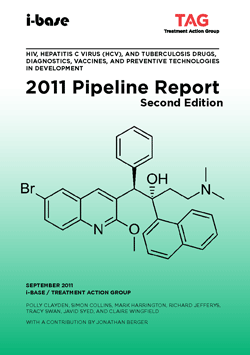HIV, Hepatitis C Virus (HCV), and Tuberculosis Drugs, Diagnostics, Vaccines, and Preventive Technologies in Development
Second Edition
September 2011
Written by Polly Clayden, Simon Collins, Mark Harrington, Richard Jefferys, Tracy Swan, Javid Syed, and Claire Wingfield
with a a contribution by Jonathan Berger
From the Introduction:
As this i-Base and TAG 2011 Pipeline Report, Second Edition, makes clear, medically, the prospect for people with HIV, hepatitis C virus (HCV), and tuberculosis (TB) to live long and healthy lives—and in the cases of HCV and TB, to be cured rapidly with safe, effective, oral combination therapy—has never been better.
Politically and economically, the world’s activists and political leaders face a crisis in which the former must persuade the latter to redirect billions of dollars from unproductive wars into life-saving health research and access programs, at home and internationally.
Here we will summarize the exciting progress that appears later in this report in great detail, and will look in greater depth at the last and the next decades of HIV treatment research.
Globally, 34 million people are living with HIV infection, an estimated 2 billion with latent Mycobacterium tuberculosis (TB) infection, and up to 130 million with chronic HCV infection.
At least 1.8 million people died from AIDS in 2009, one quarter of them from TB, which on its own killed 1.7 million people. There is neither global nor national surveillance for HCV-related illness and death, but more than 300,000 people die from HCV complications each year, and HCV mortality will continue to increase in the coming decade.
HIV infection can be controlled with lifelong triple-combination antiretroviral therapy (ART). Latent TB infection can be treated with six to nine months of isoniazid (INH) or 12 weeks of once-weekly rifapentine and INH. Active TB disease, if drug-susceptible, can be cured in 95% of cases with four drugs in six months, while drug-resistant forms of the disease can be cured up to 70% of the time if multidrug-resistant, or just 30% if extensively drug-resistant, with unpleasant combinations that can take up to two years to work, if they work at all. HCV is now curable in up to 75% of infected people with genotype 1 (predominant in major pharmaceutical markets) who have access to—and can tolerate—today’s standard of care: triple therapy with pegylated interferon, ribavirin, and an HCV protease inhibitor.
As the writers of this report reveal, the prospects for dramatic—indeed in some cases revolutionary—changes in prevention and treatment for the three diseases in the next decade are amazingly good. Decades of high-quality research, increased investment, andgrowing and targeted community-based activism have set the scene for the possibility—for the first time since HIV/AIDS emerged in 1981—to make dramatic reductions in new HIV infections worldwide, while saving the lives of as many of the 34 million currently infected who can access therapy. Treatment is continually improving, with modern combinations dramatically less toxic, more tolerable, and easier to take than the first-generation ART combinations of the 1990s.

